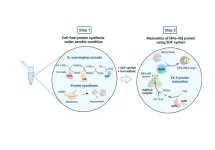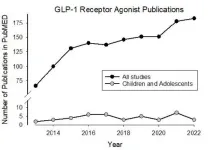(Press-News.org) **EMBARGOED UNTIL 3:00am CT TUESDAY, AUGUST 29, 2023**
Tulsa, Okla. – A trailblazing study conducted by researchers at the Laureate Institute for Brain Research (LIBR) in Tulsa, Okla., has made significant strides with a novel technique for treating anorexia nervosa (AN), an eating disorder characterized by low body weight, body image abnormalities, and anxiety. The study, “The impact of floatation therapy on body image and anxiety in anorexia nervosa: a randomized clinical efficacy trial,” appears in the peer-reviewed scientific journal eClinicalMedicine, a part of The Lancet Discovery Science initiative.
The researchers identified several immediate and sustained effects of Floatation-REST (Reduced Environmental Stimulation Therapy) in inpatients with anorexia nervosa. Also known as “float therapy”, Floatation-REST is a non-pharmacological treatment that involves floating effortlessly in a shallow pool of warm water saturated with Epsom salt, in a lightproof, soundproof, humidity- and temperature-controlled environment, and it is increasingly used by the general public as a stress reduction tool. In the study, the anorexia nervosa inpatients randomized to receive floatation-REST reported immediate and repeated reductions in body image dissatisfaction and improved anxiety relative to a comparison group of anorexia nervosa inpatients randomized to receive care as usual, whose symptoms were unchanged. Moreover, the body image improvements in the floatation-REST group remained after the treatment and lasted for up to six months.
“This breakthrough offers a new therapeutic direction in treating anorexia nervosa, a psychiatric disorder known for its challenging prognosis and high mortality rate,” said psychiatrist Sahib Khalsa, MD, PhD, Director of Clinical Operations at LIBR, and senior author of the study. “Anxiety is a common co-occurrence in anorexia nervosa that does not respond well to standard anxiolytic medications such as benzodiazepines,” he added. “The large anxiety reductions induced by float therapy in these patients suggest that this tool presents a potent opportunity to treat anxiety via non-pharmacological means in anorexia nervosa. Additional research is needed to examine the anxiolytic effects of float therapy in other eating disorders.”
“These findings also make way for new forms of treatment for eating disorders which, in conjunction with traditional treatments, may help to alleviate diagnostic features of AN that are more difficult to treat, such as body image,” commented co-first author Emily Choquette, PhD, a clinical psychologist and postdoctoral scholar at LIBR. “The reliable and sustained effect of floatation-REST on body image dissatisfaction suggests that it may be studied as a tool to augment the effectiveness of traditional psychotherapies.”
Because anorexia nervosa is a severe and persistent psychiatric disorder, the search for effective treatments is ongoing. “This study underscores the importance of continually seeking innovative approaches and broadening the horizons of existing therapeutic options,” added Dr. Scott Moseman, MD, CEDS, Medical Director of the Laureate Eating Disorders Program. “These findings may pave the way for new forms of treatment, such as float-assisted psychotherapy, which aim to further enhance the body image and anxiety improvements obtained via existing evidence-based interventions.”
The research team was led by senior author Sahib Khalsa, MD, PhD, Director of Clinical Operations at the Laureate Institute for Brain Research, Director of the LIBR Float Clinic and Research Center, Associate Professor in the Oxley College of Health Sciences at The University of Tulsa, and conducted in close collaboration with psychiatrist Scott Moseman, MD, CEDS, Medical Director of the Laureate Eating Disorders Program from which the participants were recruited. Co-first authors on the study were Emily Choquette PhD, a post-doctoral research associate at LIBR, and Michael Flux PhD, a former lab volunteer and collaborator at LIBR. Additional collaborators included clinical neuropsychologist Justin Feinstein, PhD, President and Director of the nonprofit Float Research Collective.
The research was supported by the Laureate Institute for Brain Research and was conducted at LIBR between March 2018 and February 2021.
# # #
CONTACT: For more information about the study, contact Sahib Khalsa, MD, PhD, at Laureate Institute for Brain Research at skhalsa@laureateinstitute.org.
ABOUT LAUREATE INSTITUTE FOR BRAIN RESEARCH (LIBR)
Launched in 2009, the Laureate Institute for Brain Research is home to a multidisciplinary team of scientists and clinical research staff who apply neuroimaging, genetic, pharmacological, neuropsychological and psychotherapeutic methods to investigate the neurobiology and treatment of psychiatric disorders. LIBR’s creation was supported by The William K. Warren Foundation for the purpose of conducting studies aimed at developing more effective treatments and/or prevention strategies for these disorders. The studies are led by scientists from diverse backgrounds, including psychiatry, psychology, physics, cognitive neuroscience, developmental neuroscience, population neuroscience and genetics, molecular and cellular neurobiology, and computer science.
END
Innovative therapy for anorexia nervosa shows promise
2023-08-29
ELSE PRESS RELEASES FROM THIS DATE:
An investment in more research to benefit children and adolescents
2023-08-29
Launched in 2019, the Botnar Research Centre for Child Health (BRCCH) aims to drive innovative health research that benefits children and adolescents globally – especially those living in low- or middle-income countries. Within this centre, the University of Basel and ETH Zurich work in partnership with the University Children’s Hospital Basel (UKBB) and the Swiss Tropical and Public Health Institute (Swiss TPH).
Over the past four years, the BRCCH has supported around 80 researchers and 29 research projects worldwide. For example, researchers improved the treatment of cleft lip and palate and developed biotechnology to monitor paediatric gut ...
Maintaining stable weight increases longevity among older women
2023-08-29
Reaching the age of 90, 95 or 100, known as exceptional longevity, was more likely for women who maintained their body weight after age 60, according to a multi-institutional study led by University of California San Diego. Older women who sustained a stable weight were 1.2 to 2 times more likely to achieve longevity compared to those who experience a weigh loss of 5 percent or more.
Reporting in the Aug. 29, 2023 online issue of the Journal of Gerontology: Medical Sciences, researchers investigated the associations of weight changes later in life with exceptional longevity ...
Air pollution and its threat to health are unequally spread throughout the world, and so are the opportunities to combat it
2023-08-29
As global pollution edged upward in 2021, so did its burden on human health, according to new data from the Air Quality Life Index (AQLI). If the world were to permanently reduce fine particulate pollution (PM2.5) to meet the World Health Organization’s (WHO) guideline, the average person would add 2.3 years onto their life expectancy—or a combined 17.8 billion life-years saved worldwide.
This data makes clear that particulate pollution remains the world’s greatest external risk to human health, with the impact on life expectancy comparable to that of smoking, more than 3 times that of alcohol use and unsafe water, and more than ...
Overcoming the challenges to synthesising iron–sulfur proteins outside the glovebox
2023-08-29
Fe–S clusters, which are a part of Fe–S proteins, are found across all forms of life. They play a significant role as biological cofactors—helper molecules that assist these proteins in different biochemical transformations—that are involved in respiration and metabolism. These clusters are of keen research interest since they are considered to be a critical part of evolution. They serve as a link between pre-biotic chemistry (chemical processes that existed prior to the emergence of life forms) and the complex molecular and biological systems we know today. Put simply, they ...
Mothers in prison embrace a parenting program to strengthen bonds with separated children
2023-08-29
The number of women imprisoned in Australia has jumped by 64% in the past decade, leaving thousands of children separated from their mothers and causing huge stress to both parties.
In a bid to ease the strain of separation and maintain the mother-child bond, a new prison parenting program has been developed in close collaboration with women in prison as well as prison staff and key members of the Aboriginal community in South Australia.
The Mothers Matter program, led by University of South Australia midwife and researcher Belinda Lovell, includes direct input from Aboriginal and/or Torres ...
Resistant E. coli rises despite drop in ciprofloxacin use
2023-08-29
After a nearly threefold drop in prescriptions for the antibiotic ciprofloxacin between 2015 and 2021, the rates of ciprofloxacin-resistant E. coli bacteria circulating in the community did not decline.
In fact, a study of Seattle-area women over age 50 who had not taken any antibiotics for at least a year discovered that the incidence of gut-colonizing ciprofloxacin-resistant E. coli actually increased. About 1 in 5 women in the study were affected.
Scientists at the University of Washington School of Medicine, Kaiser Permanente Washington Health Research Institute and Seattle Children’s Hospital ...
Golden rules for building atomic blocks
2023-08-29
National University of Singapore (NUS) physicists have developed a technique to precisely control the alignment of supermoiré lattices by using a set of golden rules, paving the way for the advancement of next generation moiré quantum matter.
Moiré patterns are formed when two identical periodic structures are overlaid with a relative twist angle between them or two different periodic structures but overlaid with or without twist angle. The twist angle is the angle between the crystallographic orientations of the two structures. For example, when graphene and hexagonal boron nitride (hBN) which are layered materials are overlaid on each other, the atoms in the ...
Researchers at UC Irvine issue a warning that GLP-1RA’s may be dangerous for children
2023-08-29
A team of clinicians, exercise scientists, pharmaceutical scholars, ethicists and behavioral experts at the University of California, Irvine, outlined their concerns that the use of glucagon-like peptide-1 receptor agonists (GLP-1RAs) to treat childhood obesity and type 2 diabetes may have unintended and adverse consequences for children’s health.
The commentary, Unintended Consequences of Glucagon-like Peptide-1 Receptor Agonists Medication in Children and Adolescents – A Call to Action, was published as a perspective in the Journal of Clinical and Translational Science. The article was led by Dan M. Cooper, MD, distinguished professor in the Department of Pediatrics ...
Medicine: Mozart lullaby may relive pain in newborns during blood spot test
2023-08-29
Playing a Mozart lullaby may help reduce the pain experienced by newborn babies undergoing a heel prick blood test, according to a randomised, blinded clinical trial involving 100 infants published in Pediatric Research.
Saminathan Anbalagan and colleagues measured the pain levels of newborn infants undergoing a heel prick blood test as part of routine screening for conditions such as jaundice and phenylketonuria (PKU) in New York City, New York, USA between April 2019 and February 2020. Infants were, on average, two days old and born at 39 gestational weeks, while 53% were male and 61% were Hispanic. As part of standard care, all infants ...
Saving species from extinction - high-quality kākāpō population sequencing provides breakthrough in understanding key conservation genetics
2023-08-29
High-quality sequencing of nearly the entire kākāpō population, funded through a Genomics Aotearoa project, is helping New Zealand to manage the health of this critically endangered species.
Not only is it already making a difference to kākāpō survival, but establishing sequencing methods to work with populations under threat is also likely to be the foundation for the future of endangered wildlife science in New Zealand and the rest of the world.
The state-of-the-art methods developed by Dr. Joseph Guhlin ...





